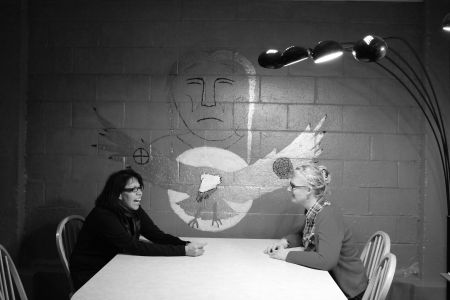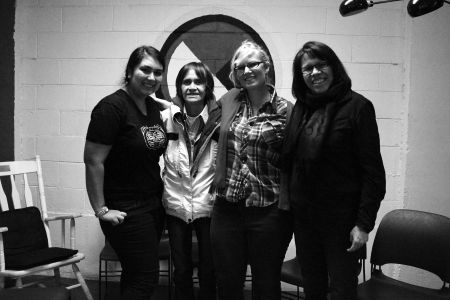VANCOUVER—In 2003, when her lungs almost collapsed from an AIDS-related pneumonia—a near-death experience she would never forget— Lyanna Storm swore to turn her life around if she survived. Storm is an HIV-positive Aboriginal woman who is currently a peer support worker for the Towards Aboriginal Health and Healing (TAHAH) program, which serves the Vancouver area and is designed to bring a holistic approach to HIV prevention, care and treatment to Aboriginal people who are not otherwise accessing care or treatment.
Rates of HIV infection among women have been on the rise in Canada in the past decade, and Aboriginal women in particular are statistically over-represented among those who have contracted the virus. According to 2008 data from the Public Health Agency of Canada, the latest figures available, Aboriginal women make up 29 per cent of all reported AIDS cases among Aboriginal people. Outside the Aboriginal population, women make up 9.1 per cent of the reported AIDS cases.
Currently, a number of community-based organizations have recognized that personal histories and socio-economic conditions are factors to consider when providing care to Aboriginal women with HIV/AIDS, and are taking steps to bring culturally-sensitive programs and peer-to-peer support to these women. Leah Sinal, case manager for TAHAH, which operates out of the Vancouver Native Health Society, said that the program was set up with the understanding that Aboriginal men and women with HIV/AIDS weren’t accessing primary health care services. It’s an initiative founded on experiential knowledge, community resources and peer health advocacy. The program is meant to engage the patients and serve as a bridge between them and health care providers.
“The [stigmatization] is really bad on the reserves and you find a lot of women not getting care there,” explained Valerie Nicholson, an Aboriginal woman who self-identifies as HIV positive. Nicholson said that one of the reasons Native women don’t access health care in the first place is because the stigma attached to having HIV/AIDS is widespread in both the mainstream population and in their own communities. They might be afraid to disclose their HIV status for fear that their family or someone in the community would find out, she suggested. “My family does know about my HIV," Storm told The Dominion. "I am treated differently, even with my family. Some of them accept it, but one brother told me to my face he hopes I die soon because I’m a disgrace to my family.”
A report entitled Aboriginal Women’s Health published by the Native Women’s Association of Canada in 2004 found that Aboriginal women are marginalized within their own communities; reasons for this include gendered racism, violence, poverty and single motherhood.
When it comes to receiving HIV/AIDS care and treatment, Nicholson says that the services in Vancouver and in the city's Downtown Eastside adequately address the needs of Aboriginal women. In a 2008 publication by the Canadian Aboriginal Aids Network (CAAN), 75 per cent of surveyed Aboriginal people with HIV/AIDS said that their primary health care needs were generally being met.
But according to the same report, access to this kind of care and services in rural communities or on reserves is still lacking. It found that there was limited access to health care professionals, transportation and counseling services, factors that led Aboriginal peoples living with HIV/AIDS to move to urban centres. Of the Aboriginal peoples living with HIV/AIDS surveyed in the study, 89 per cent live in cities.
But even in urban areas, access to these facilities is still a challenge to many Aboriginal women. Feelings of discrimination and the lack of cultural awareness from health care providers deter the women from going for regular check-ups or visits to doctors. According to the CAAN study, 30 per cent of survey respondents said they experienced racial prejudice or homophobia when seeking medical help, and 46 per cent perceive they received poor care.
“We have a strike against us as Aboriginal, first of all. And then on top of that, to find out you’re HIV [positive]; that’s a double whammy,” said Storm, as she described her experience with the health care system.
The CAAN study mentions that historical events like the residential school system have affected Aboriginal peoples' trust toward government and health care organizations. Lingering feelings of distrust due to experiences with residential schools or Indian hospitals are also possible factors in Aboriginal women’s decisions not to access the health care system for HIV/AIDS treatment, said Sinal. She suggested that there might be distrust in the people providing health care services and even distrust in the medicine itself.
In order for the mainstream health care system to become more accessible to Aboriginal women, it’s important to establish parametres for cultural understanding of Aboriginal women’s lived experiences and cultural realities. CAAN suggests providing Elder counsels, sharing or healing circles, and access to traditional medicines.
“People need to start understanding culture a lot more,” Sinal said.
Oftentimes, mainstream health care practitioners don’t have an understanding of Aboriginal women’s living conditions.
“Situations like: where does this person live? In an SRO [single room occupancy] that’s very small and possibly bug-infested? They’re living below the poverty line, maybe struggling with an addiction, to take into account that people live with everyday...I think is not recognized or empathized with,” Sinal said. Even taking into consideration that a client might not have a phone to call in order to follow-up or schedule appointments is something that hospitals do not address, she explained.
Social services or community-based programs like TAHAH seek to address this discrepancy by providing a client-centred approach to health services. Sinal said that interactions with clients are often face-to-face, and client files are always kept up to date with recent addresses and photos of the patients to better keep track of them.
Peer support groups give Aboriginal women a chance to engage in leadership and mentorship, foster community among Aboriginal women living with HIV/AIDS and help them deal with their health and emotional needs.
“We call ourselves ‘women in numbers,’ we do Aboriginal crafts, healing couches, appraising what our medicines mean, get Elders to teach us different things because we’ve lost so much,” Nicholson said, describing her peer group.
As she’s learned more about traditional ways and gone back to traditional foods and medicine, Nicholson said that her health has taken a turn for the better, increasing her CD4 count, which measures white blood cells that fight infection. It has reached 800 to 1,100, compared to a CD4 count of 400 before she went back to traditional foods.
“I’d really like to see services like this [TAHAH] program,” said Sinal, explaining that this would include “more learning from outside clinics or specialists or hospitals in how [TAHAH staff] work and engage with people.” Sinal maintains that letting people who have been pushed down be “in the driver’s seat for a change,” allows them to take charge of their health and their lives.
Phoebe Yu is a Vancouver based writer.




